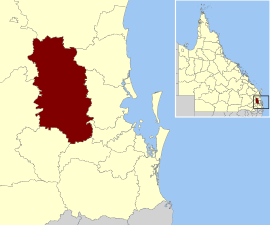| Somerset Region Queensland | |||||||||||||||
|---|---|---|---|---|---|---|---|---|---|---|---|---|---|---|---|
 Location within South East Queensland | |||||||||||||||
| Population | 25,057 (2021 census)[1] | ||||||||||||||
| • Density | 4.6635/km2 (12.0784/sq mi) | ||||||||||||||
| Established | 2008 | ||||||||||||||
| Area | 5,373 km2 (2,074.5 sq mi)[2] | ||||||||||||||
| Mayor | Graeme Lehmann | ||||||||||||||
| Council seat | Esk | ||||||||||||||
| Region | South East Queensland | ||||||||||||||
| State electorate(s) | |||||||||||||||
| Federal division(s) | |||||||||||||||
 | |||||||||||||||
| Website | Somerset Region | ||||||||||||||
| |||||||||||||||
The Somerset Region is a local government area located in the West Moreton region of South East Queensland, Australia, northwest of the City of Brisbane. The region is centred on the town of Esk, which also serves as the council seat. Somerset was created in 2008 from a merger of the shires of Esk and Kilcoy, and is known as the Brisbane Valley, owing to the Brisbane River which courses through the region.[3] However, significant parts of the region lie outside the hydrological Brisbane Valley.
The original shires of Esk and Kilcoy were amalgamated to consolidate the water catchments (or reservoirs) of the Wivenhoe and Somerset dams. The Local Government Reform Commission identified that the long-term future of Somerset would be as a major water catchment area for the South East Queensland region, with farming constituting the main economic activity within a water catchment management regime. The "planning strategy and land use policies" implemented by the Somerset Regional Council are therefore "directed this end".[4]
The Somerset Regional Council, which administers the region, has an estimated operating budget of A$50 million. (Council's 2011/2012 budget adopted in June 2012 showed total operating revenue of A$50,049,250[5]). The Somerset region comprises the primary water catchments for the Somerset and Wivenhoe Dams that form an essential part of the water supply grid for South East Queensland.[6]
In the 2021 census, the Somerset Region had a population of 25,057 people.[1]
- ^ a b Cite error: The named reference
Census2021was invoked but never defined (see the help page). - ^ "3218.0 – Regional Population Growth, Australia, 2017-18: Population Estimates by Local Government Area (ASGS 2018), 2017 to 2018". Australian Bureau of Statistics. Australian Bureau of Statistics. 27 March 2019. Archived from the original on 27 March 2019. Retrieved 25 October 2019. Estimated resident population, 30 June 2018.
- ^ Egan, Geoff (29 May 2012). "Individual marketing for Somerset". The Queensland Times. Archived from the original on 15 September 2012. Retrieved 22 June 2012.
- ^ Local Government Reform Commission (July 2007). "Report of the Local Government Reform Commission Volume 1" (PDF). p. 12. Archived from the original (PDF) on 20 March 2012. Retrieved 23 June 2012.
- ^ "Somerset Regional Council Budget, 29 June 2012". Archived from the original on 13 February 2012.
- ^ South East Queensland Water Grid[permanent dead link]. Map. Retrieved on 24 June 2012.